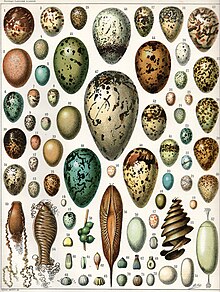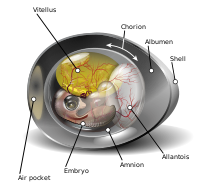egg
The egg , in Latin ovum , is a system that is formed at an early stage of development ( ontogeny ) of an egg-laying animal ( oviparous ). It consists of a female germ cell , also called an egg cell , nutrients and protective coverings ("shell"). The egg is created during oogenesis and in it the embryo develops from the mostly fertilized egg cell .
Because of their high nutritional value, many eggs are a coveted food for numerous animal species and also for humans. In response, numerous strategies have evolved to protect the egg and thus improve the survivability of each species.
In common parlance, the term is understood to be the domestic chicken's egg , the hen's egg . This narrowing of the term is also reflected, for example, in food regulations that define the egg as a hen's egg if the animal species is not specified.
etymology
That is common. Word mhd. , Ahd. Ei goes back to idg. Ō (u̯) i̯-im , which is an education to idg. Əu̯ei- "bird". As a name for a food, egg generally stands for the hen's egg . In a concise form, the term egg describes the egg cell itself.
Layout and function

Due to its shell, an egg is a self-contained system and offers the developing being a shelter for a limited time. In this room there is initially a depot of substances that serve as resources for the required energy and the build-up of body mass. The egg stage ends when it hatches , usually when the animal's depot is almost completely used up.
Animal species, especially lower crustaceans such as copepods , can serve as a permanent stage in order to survive longer, particularly unfavorable periods of drought, winter cold or lack of food. Such eggs are often more robust and adapted to the unfavorable external conditions. They are called permanent eggs (also winter eggs or lathe eggs ). The permanent eggs of the daphnia (water fleas) can develop into embryos even after decades, from those of the copepod Diaptomus sanguineus individuals hatched after 330 years.
Egg cell
The egg is a system that is built around an egg cell. The egg cell itself is a single female germ cell. Depending on the animal group, this can be either unfertilized or fertilized by a male germ cell ( sperm ).
In the case of eggs, it cannot be ruled out - but it is rather rare - that they contain several seedlings. With chicken eggs it can occasionally happen that one egg contains several yolks. Such eggs are usually somewhat larger than comparable objects from the same animal. If these eggs were fertilized, ideally two chicks would hatch from one egg .
yolk
Nutrients stored in special places in the egg are called yolks . The yolk can be stored directly in the egg cell (endolecithal eggs) or in the form of yolk cells (vitellocytes). The yolk is produced either by the egg cell alone (endosynthetic) or partially outside the egg cell by other cells (exosynthetic).
In many original aquatic animals, a tiny larva hatches from the egg after a short time and feeds itself independently, so that only a small amount of yolk needs to be present in the egg cell. Such eggs are called low- yolk or oligolecithal. Among the vertebrates, most fish and amphibians lay low-yolk eggs. In eggs that hatch quite well developed young animals, the egg cell is very large and consists predominantly of yolk. In these yolk- rich or polylecithal eggs, the first cell divisions, called furrows , differ significantly from the conditions in eggs with little yolk .
Egg shells
In the case of the egg shells, which are also called egg membranes , a distinction can be made between primary, secondary and tertiary egg shells. Each of these egg shells can consist of several layers.
- The primary egg shell (s) is or are formed in the ovary by the egg cell (oocyte) itself. An example of this is the yolk membrane of the chicken egg .
- The secondary egg shell (s) is or are secreted by the follicular epithelial cells in the ovary. This includes the so-called chorion of insect eggs. This is often relatively stiff and characteristically sculptured, so that the insect species can also be identified at this stage. Whether the chorion of fish eggs and the zona pellucida of mammalian ova are primary or secondary egg shells is a matter of dispute. Both primary and secondary egg envelopes are usually permeable to sperm because they are formed before fertilization.
- The tertiary egg shell (s) is or are only formed in the fallopian tube (oviduct), often only after fertilization. These include, for example, the albumen , the shell membranes and the often chalky outer shell of the eggs ( eggshell ) of non-viviparous vertebrates that can reproduce independently of the water ( oviparous amniotes : reptiles , birds , ursal mammals ), such as the hen's egg.
Size and shape
The size and shape of eggs is very different, ranging from microscopic, endolecithal eggs with a diameter of around 50 μm, such as those found in sponges , cnidarians and many other animal groups, to eggs several centimeters in diameter, such as many Bone fish or the African ostrich with a diameter of 15 centimeters.
The extinct elephant bird ( Aepyornis maximus ) possessed the world's largest egg with a maximum length of 34 centimeters and a width of 22.5 centimeters, even of extinct dinosaurs no such large eggs are known. The eggs of the birds, which were up to three meters in size, had a volume of around nine liters - the equivalent of around seven ostrich eggs or almost 200 chicken eggs. The largest known dinosaur eggs come from large predatory dinosaurs and are roughly loaf-shaped as well as from sauropods . Finds from Argentina showed that their eggs were round (max. Diameter 25 cm) and had a content of no more than four liters.
Since eggs do not have any external organs such as limbs or fins, mouthparts and sensory organs, they are simply shaped, the longitudinal section is usually an oval . The variations range from the frequent spherical shape to the rounded cylinder ("pen"), as it often occurs in insects, and the almost conical guillotine egg . However, some eggs have external appendages that are used for attachment, such as the eggs of rays .
Stalked egg of a lacewing (right)
Spawn of the purple snail
Shell of a Roche egg
Nile crocodile eggs
Egg laying and brood care

In the most original case, especially in sedentary ( sessile ) animals, the unfertilized egg cells and sperm are simply released into the water. Mobile aquatic animals usually lay their eggs in particularly suitable places, for example trout fish create special spawning pits in the gravel for spawning , common toads wrap their spawning lines around aquatic plants. The chances of survival of the eggs are increased by brood care , such as guarding the eggs for fish species such as sticklebacks and incubating with birds. In extreme cases, the eggs are hatched in the womb, for example in ovoviviparous sharks and rays or the viviparous toothcarps , but also in various invertebrates in which the females die in the course of egg development.
The entirety of the viable eggs deposited in one place are called clutch.
Use by humans
nutrition
The main human use of eggs is as a food . By far the most widely used bird egg in the world is the chicken egg , which was and is not only used as a boiled or scrambled egg and as an ingredient in various dishes , but also in technology (e.g. in some tempera paints or historical mortar .)
In addition to the eggs of domesticated farm animals , especially chickens , eggs from wild animals and / or animals that are difficult to cultivate are also collected and used. This can threaten the survival of some species, such as sea turtles or sturgeon , which are caught and killed for caviar extraction .
Cultural meaning
Because of their importance to humans, chicken and other eggs are also important in culture. In the past, ostrich egg shells were used to make magnificent, richly decorated drinking vessels, today lampshades or decorative objects are made from the shells.
In traditional customs, colored or decorated hard-boiled eggs or blown decorated eggshells are used as Easter eggs or Easter decorations for Easter . Eggs as grave goods have been documented since the 4th century.
See also
- Columbus egg - idiom
- Atomei - Research Reactor Munich I
- vulgo for testicles
literature
- Robert Ebermann, Ibrahim Elmadfa: Textbook food chemistry and nutrition. Springer-Verlag 2011, ISBN 3-7091-0211-1 , p. 334.
- Monika Offenberger : The egg. Origin of all life. Primus-Verlag 2013, ISBN 978-3-86312-003-0
Web links
Individual evidence
- ↑ a b " Ei ", keyword in the lexicon of biology, Spektrum.de; Retrieved April 25, 2015.
- ↑ Federal Department of the Interior (FDHA), as of May 1, 2017: Ordinance of the FDHA on food of animal origin (Chapter: Eggs and egg products) , accessed November 29, 2018
- ^ The dictionary of origin (= Der Duden in twelve volumes . Volume 7 ). 5th edition. Dudenverlag, Berlin 2014 ( p. 241 ). See also Friedrich Kluge : Etymological dictionary of the German language . 7th edition. Trübner, Strasbourg 1910 ( p. 107 ).
- ↑ permanent eggs. In: Spectrum Lexicon of Biology. Retrieved September 15, 2019 .
- ^ Winfried Lampert, Ulrich Sommer: Limnoökologie . Georg Thieme Verlag, 1999, p. 66-67, 208, 318 .
- ↑ a b Reinhard Rieger : Metazoa, Tierische Vielzeller. in: W. Westheide, R. Rieger (Ed.): Special Zoology Part 1: Protozoa and Invertebrates. Gustav Fischer Verlag, Stuttgart and Jena 1996; P. 89. ISBN 3-437-20515-3 .
- ↑ Chris P. Raven: Oogenesis: The Storage of Developmental Information. Pergamon Press, 1961, p. 38 f.
- ↑ a b c egg cases . Spectrum online lexicon of biology
- ^ Anne-Katrin Eggert, Josef K. Müller, Ernst Anton Wimmer, Dieter Zissler: Reproduction and Development. P. 363–459 in: Konrad Dettner, Werner Peters (Ed.): Textbook of Entomology. 2nd edition, Spektrum / Elsevier, Munich 2003, ISBN 3-8274-1102-5 , p. 369
- ^ Jiří Mlíkovský (2003). "Eggs of extinct aepyornithids (Aves: Aepyornithidae) of Madagascar: size and taxonomic identity". Sylvia 39: 133-138. (PDF; 172 kB)
- ↑ The largest egg in the world , by Dr. Ralf Breyer, April 10, 2003 at idw-online.de, accessed on October 3, 2019
- ↑ Czech Republic online: Ancient legend confirmed: Eggs detected in the mortar of Charles Bridge in Prague , accessed July 4, 2012
- ↑ Das Grünes Gewölbe Dresden : Ostriches as drinking vessels by Elias Geyer (before 1610), ostrich egg cups in German, southern German (around 1600)








